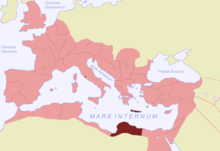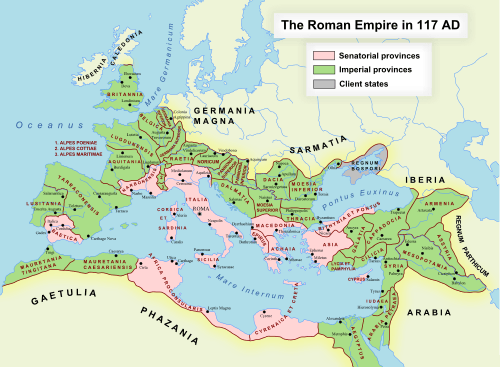Crete and Cyrenaica
Crete and Cyrenaica (Latin: Provincia Creta et Cyrenaica) was a senatorial province of the Roman Empire, established in 67 BC. It comprised the island of Crete and the region of Cyrenaica in present-day Libya.
| Provincia Creta et Cyrenae Ἐπαρχία τῆς Κρήτης καὶ τῆς Κυρηναϊκῆς | |||||||||
|---|---|---|---|---|---|---|---|---|---|
| Province of the Roman Empire | |||||||||
| 67 BC–c. 297 AD | |||||||||
 Roman province of Creta et Cyrenae highlighted. | |||||||||
| Capital | Gortyn | ||||||||
| History | |||||||||
• Established | 67 BC | ||||||||
• Disestablished | c. 297 AD | ||||||||
| |||||||||
| Today part of | |||||||||
Apion's will and Roman rule of Cyrenaica
Ptolemy Apion, the last king of the Hellenistic Kingdom of Cyrenaica left his kingdom to the Roman Republic when he died childless in 96 BC.[1] Rome readily accepted this inheritance from Ptolemy Apion but preferred to leave the administration to local rulers, rather than enforcing direct control. However, by the 70s BC, civil uprisings by Jewish settlers began to destabilise the province and the Senate was forced to take action. In 74 BC, they sent a low level official, the quaestor Cornelius Lentulus Marcellinus, to officially annex Cyrenaica as a Roman province and restore order. That the Senate sent such a low-ranking official indicates the political difficulty the Republic had in governing its growing empire, as well as indicting the ease with which Cyrenaica was willing to submit to Roman governance and the stability it brought.[2]
Roman conquest of Crete
Marcus Antonius Creticus attacked Crete in 71 BC and was repelled. Then in 69 BC, Rome commissioned Quintus Caecilius Metellus and, following a ferocious three-year campaign, Crete was conquered for Rome in 66 BC, Metellus earning the agnomen "Creticus" as an honour for his conquest and subjugation of Crete.[3]
Province
In 67 BC, Crete and Cyrenaica were combined into a single province[4] with its capital at Gortyn in Crete. Because this arrangement was geographically inconvenient Diocletian divided the province in 298 AD.[3][5]
List of Roman governors
- C. Clodius Vestalis Between 30 BC and AD 14[6]
- M. Titius Between 30 BC and AD 14
- Pomponius Secundus Between AD 37 and 54
- Fabius Before 13 BC
- P. Sextius Scaeva 7/6 BC
- Q. Lucanius Proculus After 13 BC
- L. Plotius Vicinas Between 2 BC and AD 7
- (Lollius) Palikanus Between 30 BC and AD 14
- Marcus Nonius Balbus Between 30 BC and AD 14
- Scato Between 30 BC and AD 14
- Gaius Rubellius Blandus Between 30 BC and AD 14
- Caesius Cordus c. AD 12
- P. Octavius Between AD 14 and 29
- Occius Flamma Between AD 14 and 37
- Cornelius Lupus Between AD 14 and 37
- P. Viriasius Naso
- Celer
- Augurinus Between AD 37 and 41
- Q. Cassius Gratus Before 53
- Caesernius Veiento 46/47?
- Publius Pomponius Secundus Between 37 and 54
- Cestius Proculus Before 56
- Pedius Blaesus Before 59
- Bruttidius Sabinus First half 1st century
- Lucius Turpilius Dexter 64/65
- Titus Atilius Rufus 67
- Aulus Minicius Rufus 71/72[7]
- Catullus 72/73
- Gaius Arinius Modestus 73/74-74/75
- Silo
- Aulus Julius Quadratus 84/85
- Gaius Pomponius Gallus Didius Rufus 88/89
- Gaius Memmius [...] 98/99
- Lucius Elufrius Severus 99/100
- Lucius Aemilius Honoratus Between 97 and 118
- Titus Vibius Varus Between 97 and 118
- Salvius Carus 134/135
- Quintus Caecilius Marcellus Dentilianus c. 140[8]
- Quintus Julius Potitus Between 138 and 161
- Gaius Claudius Titianus Demostratus 161/162
- Pomponius Naevianus Between 165 and 169
- Veturius Paccianus Before 168
- Lucius Saevinius Proculus 173/174
- Quintus Caecilius Rufinus Between 160 and 180
- Quintus Servilius Pudens 164/165
- Lucius Clodius Tineius Pupienus Bassus 250
Further reading
Jane Francis and Anna Kouremenos (eds.) 2016. Roman Crete: New Perspectives. Oxford: Oxbow
Anna Kouremenos 2018. "In the Heart of the Wine-Dark Sea: Cretan Insularity and Identity in the Roman Period". In A. Kouremenos (ed.) Insularity and Identity in the Roman Mediterranean. Oxford: Oxbow.
References
- "Ptolemy Apion". Chris Bennett. Retrieved 2016-11-24.
- "Cyrenaica". UNRV.com. Retrieved 2016-11-24.
- "Crete". UNRV.com. Retrieved 2016-11-24.
- "Cyrenaica historical region, North Africa". Encyclopaedia Britannica. Retrieved 27 December 2017.
- "Cyernaica". Livius.org. Retrieved 2016-11-24.
- Unless otherwise stated, the names of the proconsular governors from 30 BC to AD 67 are taken from Werner Eck, "Über die prätorischen Prokonsulate in der Kaiserzeit. Eine quellenkritische Überlegung", Zephyr 23/24 (1972/73), pp. 246f
- Unless otherwise stated, the names of the proconsular governors from 71 to 135 are taken from Werner Eck, "Jahres- und Provinzialfasten der senatorischen Statthalter von 69/70 bis 138/139", Chiron, 12 (1982), pp. 281-362; 13 (1983), pp. 147-237
- Unless otherwise stated, the names of the proconsular governors from 140 to 165 are taken from Géza Alföldy, Konsulat und Senatorenstand unter der Antoninen (Bonn: Rudolf Habelt Verlag, 1977), pp. 263f
